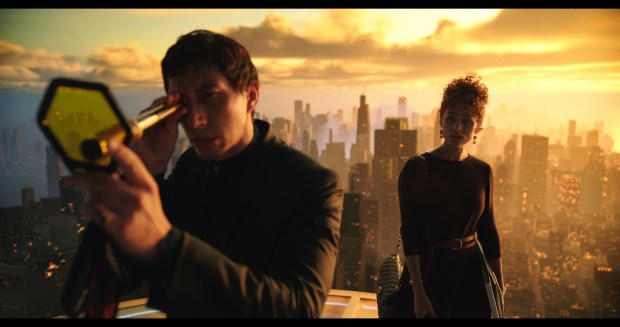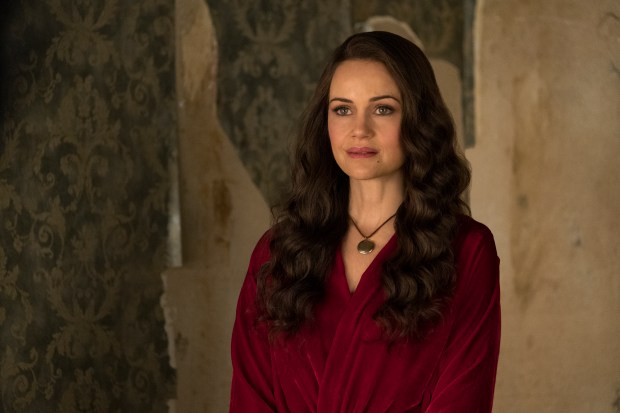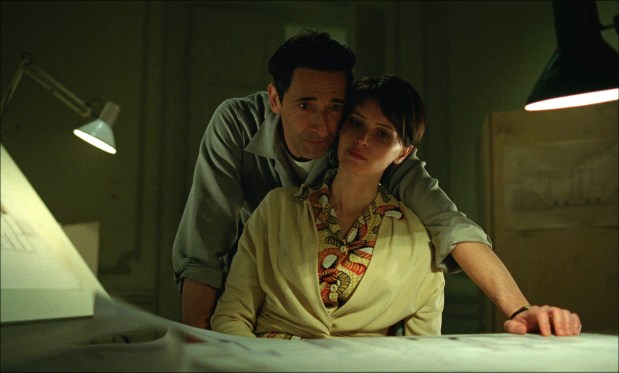“There’s no place for originality in architecture! Nobody can improve on the buildings of the past!”
Those are the second and third lines spoken in the 1949 film version of Ayn Rand’s “The Fountainhead,” adapted by Rand, contractually protected from studio meddling, from her 1943 bestseller about the world’s hunkiest and most uncompromising visionary architect. The story culminates in the construction of the world’s tallest building, and a godlike man’s fulfillment of the destiny of the planet he shares, reluctantly, with smaller minds and aesthetic weaklings. One such weakling, the architecture school dean expelling his untamed prodigy Howard Roark (played by Gary Cooper), is the first voice heard in “The Fountainhead.”
The movies have long exploited a select handful of go-to professions for stories of obsessive creatives, creating. Sometimes it’s a real-life singer-songwriter, blowin’ in the wind from the recent past, a la “A Complete Unknown.” Or a real-life theoretical physicist who risks destroying the world in order to end a war, aka “Oppenheimer.”
Lately it’s architects, fictional division, two in particular. “The Brutalist” concerns a fictional Hungarian Jew, one László Tóth (played by Adrien Brody), who survives the Holocaust and sails to America in 1947. Here, his Bauhaus-trained credentials and pre-war design achievements mean little.
A stroke of luck arrives, at a price. The son of a wealthy industrialist commissions a library renovation as a surprise to his stuffy, imperious father (Guy Pearce). This man, Harrison Lee Van Buren, loathes the modernist results, at least until Look magazine lavishes praise on the architect and the Van Buren library. Directed and co-written by Brady Corbet, “The Brutalist” devotes a significant chunk of its running time to Toth’s magnum opus: a huge, concrete community center outside Doylestown, Pennsylvania, commissioned by Van Buren, designed by Tóth in the Brutalist architectural style seen as an affront to every Neoclassical, tradition-bound bone in his adopted country’s body.
Brody’s character is Mr. Easygoing compared to Adam Driver’s supernaturally gifted genius in “Megalopolis,” the sole movie architect whose arrogance exceeds Ayn Randian levels. Writer and director Francis Ford Coppola does not hold back. “You find me cruel, selfish and unfeeling?” Driver asks his future adoring wife, quickly answering his own question with: “I am.” He doesn’t say “I am, because I am an architect!” only because there’s no need.
I talked with Chicago’s Anjulie Rao about the architect’s screen image, the terrors and pleasures of Brutalist design and (since she brought him up) America’s highest-ranking amateur architecture expert . Rao, of Garfield Park, lectures at the School of the Art Institute of Chicago and contributes to Dwell magazine, for which Rao recently interviewed “The Brutalist” production designer Judy Becker. Our conversation is edited for clarity and length.
Q: Anjulie, you’ve seen both “The Brutalist” and “Megalopolis.” Are we stuck with a certain image of the difficult, uncompromising architect, as different as these films are?
A: Well, I do think “The Brutalist” doesn’t settle for the trope of “one man changing the world with his vision.” The Adrien Brody character escapes the Buchenwald concentration camp but he hasn’t escaped his trauma. He’s tormented. And he’s not viewed as any kind of genius by anyone except maybe his patron, the Guy Pearce character. That relationship, patron and architect, is two men feeding off each other, reaffirming each other’s worst traits. And it makes them feel both smarter and more in control than they are, really.
Q: For those who don’t know what the title “The Brutalist” refers to, outside the familiar meaning of “brutal,” what does Brutalism mean to you?
A: It’s the most loved and the most hated style of architecture. It’s also the thing our new president deplores, as he made clear in his first term. He really hates the FBI headquarters in Washington, D.C., for example, which is Brutalist in its heavy concrete structure, and very small windows strategically placed so that light comes in at unusual angles. Often with Brutalist buildings, there’s a kind of sunken garden, a sunken plaza area, so that you step down in order to enter the building. When I was in grad school at SAIC, I remember reading about surveys of people’s feelings about these sunken plazas, which a lot of people hated. It felt like people were sort of looking down on them.
So Brutalism is a not-loved style. Walk around UIC’s campus sometime, which is almost all Brutalist buildings. You’ll find out where you are on the style pretty quickly. I actually love Brutalism for its craft and the texture-heavy buildings. I personally love Brutalism. My dad worked at the IBM campus in Boulder, Colorado (now closed), which is a long, low, Brutal building. I feel like I grew up with it.
Q: I love so much of what “The Brutalist” production designer Judy Becker does to show you the make-or-break project under construction without showing you the entire thing. It’s just fragments we see. Your dad worked for IBM; in Racine, Wisconsin, my dad worked at the Johnson Wax building designed by Frank Lloyd Wright. “The Brutalist” borrows Wright’s skinny columns from the Johnson Wax administration building!
A: Wright’s Prairie School style of modernism exists in that long lineage of modernism. Brutalism has its own place, and can be minimal in some ways, but with a much heavier aesthetic.
If you look at “Megalopolis,” that’s nothing like “The Brutalist.” It’s completely dedicated to the myth of the lone male genius architect. In the most offensive way (laughs). Everyone has to worship at his altar. That’s different from “The Brutalist,” which pays some attention to Tóth’s journalist wife, Erzsébet (Felicity Jones), though in the end Tóth is strapped in his own traumatic past. And it informs why he behaves the way he does.
Particularly after COVID, I think more and more people are sensitive to the built environments around them, how cities look and feel. In America, at least, a lot of people are trying to figure out where they belong. That search for belonging feels more profound than ever. I don’t know if “The Brutalist” is tapping into that, but it might be.

Q: What’s your feeling about the state of Chicago’s design future?
A: I feel a little … jolted by the last couple of years, like we’ve hit the brakes. With eight years of Rahm Emanuel and one term with Lori Lightfoot, we had mayors who were design- and architecture-forward. Rahm was more focused on architecture as an object of culture, not so much an object of wealth creation. Lightfoot had more of a wealth creation idea, and her planning and development commissioner, Maurice Cox, had a real belief in (bolstering) the South and West Sides. With Rahm we got the Riverwalk, which is great, and Lightfoot gave us a revitalized city plan. And now, with Brandon Johnson, it’s more about cutting red tape and rethinking regulations for developers.
Q: So the aesthetics ….
A: Are in the back seat now. (pause) Sometimes I feel down about the state of architecture. There certainly isn’t much enthusiasm for extravagance anymore.
Q: Is that a purely economic matter, you think?
A: It may also be that people are more focused on interior spaces, the places they inhabit. And when we get another new glass tower, like Salesforce Tower Chicago, it kind of blends in with the rest of the glass towers.
Q: So they’re the Marvel movies of architecture?
A: Yep. Here comes another one!

Q: Give me a movie about an architect people may not know, one that you really like.
A: Ooh! “The Haunting of Hill House,” the Netflix show (from 2018). I love it because the lead character, the mother (Carla Gugino), is an architect and she’s dealing with this house that basically devours people. And she uses her architectural drawings to save her from being devoured herself. I mean, that’s a beautiful use of architecture. But I’m a lowbrow.
I’m kind of over the thinking that poetry, filmmaking, writing, architecture all has to touch everyone, or has to make some large comment on the world. Or shift people’s perspectives on everything in life. Architecture doesn’t have to change the world, or the course of history. Buildings usually just change the lives of somewhere between one and 300 people.
I don’t think “The Brutalist” isn’t meant to be “educational.” I like that’s it’s actually very small. It’s not about how one man changed the course of history.
Q: So, the quicker we get “The Fountainhead” in the rearview mirror, the better?
A: Right. Let it go! Let things be small.
“The Brutalist” is now in theaters.
Michael Phillips is a Tribune critic.




